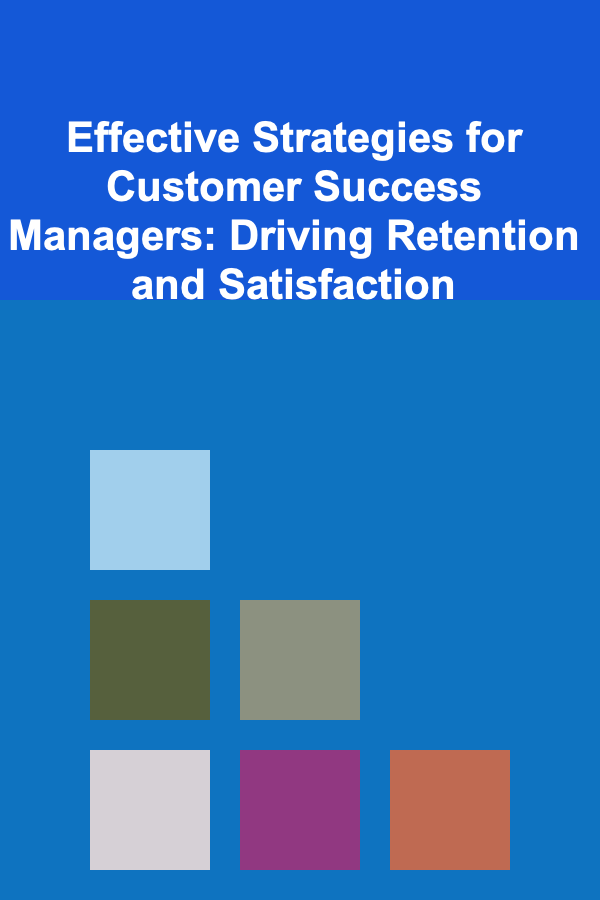
Effective Strategies for Customer Success Managers: Driving Retention and Satisfaction
ebook include PDF & Audio bundle (Micro Guide)
$12.99$6.99
Limited Time Offer! Order within the next:

Customer Success Managers (CSMs) play a crucial role in enhancing customer satisfaction, driving retention, and ensuring that customers derive maximum value from the products or services they have purchased. In a highly competitive business environment, the responsibility of CSMs goes far beyond simply supporting customers; they are strategic partners, advocates for customer needs, and catalysts for growth.
This guide explores actionable strategies that CSMs can implement to drive customer retention, boost satisfaction, and create long-lasting relationships that contribute to both customer and company success.
Understanding the Role of a Customer Success Manager
To develop effective strategies, it's essential to first understand the key responsibilities and goals of a CSM. The role typically involves:
- Onboarding: Introducing customers to the product and ensuring they understand how to use it effectively.
- Ongoing Engagement: Maintaining regular communication, helping customers achieve their goals, and ensuring the product continues to meet their needs.
- Problem Resolution: Addressing issues quickly and effectively to prevent dissatisfaction or churn.
- Renewals and Upselling: Working proactively to ensure that customers renew contracts and identify opportunities for upselling or cross-selling.
While every interaction with the customer is important, it's essential to focus on driving value and building long-term relationships.
Personalized Customer Onboarding: The Foundation for Success
Onboarding is the customer's first experience with the product or service, and it's essential to get it right. A smooth and personalized onboarding process can set the tone for the entire customer relationship. During this phase, CSMs should focus on ensuring that customers understand how to use the product effectively and how it can address their unique pain points.
Actionable Steps for Effective Onboarding
-
Tailor the Onboarding Experience: Personalize the onboarding process based on the customer's specific needs, industry, and goals. A one-size-fits-all approach often leads to confusion and disengagement. Take time to understand what the customer hopes to achieve with your product and offer a tailored plan that aligns with their objectives.
-
Provide Hands-On Support: Offer one-on-one training sessions, webinars, or interactive tutorials to help customers get up to speed quickly. Ensure that they are comfortable using all the core features of the product. Be available for questions and provide resources such as FAQs, user guides, and video tutorials.
-
Set Clear Expectations: Outline the goals and timelines for the onboarding process. Make sure customers know what success looks like at every stage. A clear roadmap helps prevent frustration and sets them up for success early on.
-
Follow Up Regularly: After the initial onboarding sessions, schedule check-ins to monitor progress and ensure that customers are getting the most out of the product. This helps build a strong foundation and reduces the risk of churn.
Building Strong, Trust-Based Relationships with Clients
The most successful CSMs are those who develop deep, trusting relationships with their customers. Customers are more likely to stay loyal to a brand when they feel understood, valued, and supported. Building these relationships requires consistency, empathy, and communication.
Actionable Steps for Building Relationships
-
Understand Your Customer's Business: Get to know your customer's industry, business model, goals, and challenges. The more you understand their specific situation, the better you can guide them toward success. Make sure your solutions align with their long-term objectives.
-
Act as a Trusted Advisor: Position yourself as an expert in your field and a trusted advisor. Offer actionable insights, advice, and recommendations that are aligned with the customer's needs. Provide value at every touchpoint to demonstrate that you're not just a service provider, but a key partner in their success.
-
Communicate Regularly: Consistent communication is essential for maintaining a strong relationship. Be proactive in reaching out to customers, not just when they have issues, but to provide updates, share new features, or ask for feedback. Personalized check-ins demonstrate that you're invested in their ongoing success.
-
Be Transparent and Honest: Transparency builds trust. If there's a problem, be open about it and work with your customer to find a solution. Customers respect honesty and are more likely to stay loyal when they see you're committed to resolving issues swiftly and effectively.
Proactive Customer Engagement: Preventing Churn
Customer engagement doesn't stop after the onboarding phase. In fact, ongoing engagement is one of the most effective strategies for driving retention. Proactive engagement means anticipating the customer's needs and addressing issues before they become significant problems.
Actionable Steps for Proactive Engagement
-
Monitor Product Usage: Use product analytics and customer health scores to monitor how actively customers are using your product. Identify signs of underutilization or disengagement early on. For example, if a customer hasn't logged in recently or isn't using key features, this may indicate they are not finding value in the product.
-
Anticipate Needs: Based on customer usage data and feedback, anticipate future needs or challenges. Reach out to customers with relevant suggestions, such as new features, training resources, or tips that can help them optimize their use of the product.
-
Regular Check-Ins and Reviews: Schedule periodic check-ins to assess the customer's progress, discuss any challenges they're facing, and gather feedback. This proactive approach ensures that customers feel supported and valued, reducing the risk of churn.
-
Create Tailored Success Plans: Work with each customer to develop a success plan that aligns with their unique business goals. This plan should include milestones, objectives, and actionable steps that help them achieve their desired outcomes. A personalized success plan provides customers with a clear roadmap and shows that you are committed to their long-term success.
Providing Exceptional Support: Resolving Issues Quickly
Even the most engaged customers will face issues at some point. The key to maintaining satisfaction during these times is ensuring that problems are resolved quickly and effectively. A smooth support process can turn a negative experience into a positive one, reinforcing customer loyalty.
Actionable Steps for Effective Problem Resolution
-
Respond Quickly and Efficiently: Customers expect quick responses when they encounter issues. Ensure that support requests are handled promptly, and make sure your response is clear and actionable. Set up systems for escalating more complex issues to the right team members.
-
Follow Up to Ensure Resolution: Once an issue is resolved, follow up with the customer to ensure that they are satisfied with the solution. This follow-up shows that you care about their experience and are committed to ensuring that the issue doesn't recur.
-
Document and Share Learnings: Document the issues that customers face and share learnings with your team. This will help in creating better customer support processes and identifying areas where the product or service can be improved.
-
Empower Customers with Self-Help Resources: Provide customers with easy access to self-help resources like knowledge bases, community forums, and troubleshooting guides. This enables them to resolve issues on their own quickly and efficiently, reducing their reliance on support teams.
Driving Renewals and Expansions: Maximizing Customer Lifetime Value
The final stage of the customer journey involves renewals, upselling, and expansions. A satisfied, engaged customer is much more likely to renew their contract or purchase additional products. By being proactive and understanding customer needs, CSMs can drive these opportunities without being pushy.
Actionable Steps for Driving Renewals and Upsells
-
Track Renewal Dates Early: Stay ahead of renewal dates by tracking them well in advance. Reach out to customers several months before their renewal is due to check in on their satisfaction and offer any additional resources or solutions they might need.
-
Offer Relevant Upsells: As you become familiar with your customer's needs and pain points, look for opportunities to upsell or cross-sell relevant features, products, or services that add value. Make sure your recommendations are aligned with their goals and are positioned as solutions to their challenges.
-
Highlight the ROI: Regularly share metrics that demonstrate the value your product has provided. Highlight any successes, such as improvements in efficiency, cost savings, or increased revenue. Clear, data-driven insights can make a compelling case for continued investment.
-
Leverage Success Stories: Use case studies, testimonials, and success stories from similar customers to show how others have benefited from expanded services or new features. This can build confidence in customers considering upsell options.
Conclusion
Customer Success Managers are integral to a company's ability to drive customer retention, satisfaction, and long-term growth. By implementing personalized onboarding, proactive engagement, exceptional support, and a focus on renewals and expansions, CSMs can build strong, lasting relationships with customers and help them achieve their goals.
Ultimately, success in this role hinges on understanding the customer's needs, fostering trust, and delivering consistent value at every touchpoint. The strategies outlined here provide a roadmap for CSMs to create lasting impact and contribute to both customer and business success.
Reading More From Our Other Websites
- [Organization Tip 101] Step-by-Step Guide to Replacing Your Stair Treads
- [Organization Tip 101] How to Create a Weekly Meal Planning and Organization System
- [Scrapbooking Tip 101] Best Ways to Use Recycled Magazine Clippings for Collage‑Style Scrapbook Pages
- [Personal Care Tips 101] How to Choose a Lipstick That Matches Your Personality
- [Personal Financial Planning 101] How to Negotiate a Lower Interest Rate on Your Credit Cards
- [Whitewater Rafting Tip 101] Top 10 Must-Have Rafting Apparel Items for Every Skill Level
- [Personal Care Tips 101] How to Choose the Best Body Butter for Men's Skincare Needs
- [Toy Making Tip 101] Troubleshooting Common Soft Toy Mistakes and How to Fix Them Like a Pro
- [Beachcombing Tip 101] Seasonal Seashell Projects: Holiday Decorations Made from the Shore
- [Home Soundproofing 101] How to Soundproof a Garage for a Quieter Workspace

How to Design a Custom Pet Area That Fits Your Lifestyle
Read More
How to Plan a Home Renovation on a Budget
Read More
What Are Simple Steps to Organize Your Home Electronics?
Read More
How to Understand Weather Patterns for Outdoor Trips
Read More
How to Practice Self-Compassion During Weight Loss
Read More
How to Choose Wine for a Backyard Barbecue
Read MoreOther Products

How to Design a Custom Pet Area That Fits Your Lifestyle
Read More
How to Plan a Home Renovation on a Budget
Read More
What Are Simple Steps to Organize Your Home Electronics?
Read More
How to Understand Weather Patterns for Outdoor Trips
Read More
How to Practice Self-Compassion During Weight Loss
Read More